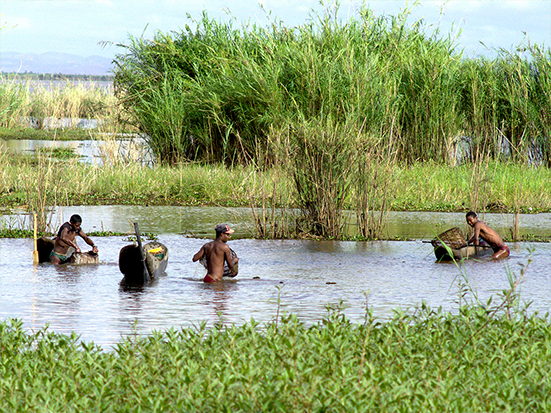Plight of the unsung ecosystems
Abstract
Although science aims to eliminate bias, it can never be fully objective. Wildlife and conservation research are far from being exempt from this tendency. For example, flagship species often take precedence over species that may be in more dire need of assistance. Factors such as species' role within ecosystems, their habitat range, degree of endangerment and taxonomic uniqueness do not stand much chance when competing against "charismatic" species receiving adulation from the public and funding agencies. This is not to say that these emblematic species should not be recipients of conservation attention. However, considering the all-too limited funding pot available to conservation projects, taking a system perspective rather than a species perspective, by considering flagship species as part of a larger whole—i.e., at the ecosystem scale—is crucial, although unfortunately not often achieved.
References
Bamford, A. J., Razafindrajao, F., Young, R. P. and Hilton, G. M. 2017. Profound and pervasive degradation of Madagascar’s freshwater wetlands and links with biodiversity. PLoS ONE 12, 8: e0182673. <https://doi.org/10.1371/journal.pone.0182673>
Darwall, W. R. T., Holland, R. A., Smith, K. G., Allen, D., Brooks, E. G. E., et al. 2011. Implications of bias in conservation research and investment for freshwater species. Conservation Letters 4, 6: 474–482. <https://doi.org/10.1111/j.1755-263X.2011.00202.x>
Dohong, A., Aziz, A. A. and Dargusch, P. 2017. A review of the drivers of tropical peatland degradation in South-East Asia. Land Use Policy 69: 349–360. <https://doi.org/10.1016/j.landusepol.2017.09.035>
Donaldson, M. R., Burnett, N. J., Braun, D. C., Suski, C. D., Hinch, S. G., et al. 2017. Taxonomic bias and international biodiversity conservation research. Facets 1, 1: pp. 105–113. <https://doi.org/10.1139/facets-2016-0011>
Jones, T. G., Glass, L., Gandhi, S., Ravaoarinorotsihoarana, L., Carro, A., et al. 2016. Madagascar’s mangroves: Quantifying nation-wide and ecosystem specific dynamics, and detailed contemporary mapping of distinct ecosystems. Remote Sensing 8, 2: #106. <https://doi.org/10.3390/rs8020106>
Kull, C. 2012. Air photo evidence of historical land cover change in the highlands: Wetlands and grasslands give way to crops and woodlots. Madagascar Conservation & Development 7, 3: 144–153. <https://doi.org/10.4314/mcd.v7i3.7>
Máiz-Tomé, L., Sayer, C. and Darwall, W. R. T. (eds). 2018. The status and distribution of freshwater biodiversity in Madagascar and the Indian Ocean islands hotspot. IUCN, Gland, Switzerland. Available online <https://doi.org/10.2305/iucn.ch.2018.ra.1.en>
Di Marco, M., Chapman, S., Althor, G., Kearney, S., Besancon, C., et al. 2017. Changing trends and persisting biases in three decades of conservation science. Global Ecology and Conservation 10: 32–42. <https://doi.org/10.1016/j.gecco.2017.01.008>
Naudin, K., Bruelle, G., Salgado, P., Penot, E., Scopel, E., et al. 2015. Trade-offs around the use of biomass for livestock feed and soil cover in dairy farms in the Alaotra lake region of Madagascar. Agricultural Systems 134: 36–47. <https://doi.org/10.1016/j.agsy.2014.03.003>
Neugarten, R. A., Honzák, M., Carret, P., Koenig, K., Andriamaro, L., et al. 2016. Rapid assessment of ecosystem service co-benefits of biodiversity priority areas in Madagascar. PLoS ONE 11, 12: 1–25. <https://doi.org/10.1371/journal.pone.0168575>
Rakotoarivelo, N. H., Manjato, N. V., Andriamiarisoa, L. R., Bernard, R. and Andriambololonera, S. 2019. Useful plants in the Park Bandro and its surroundings, Lake Alaotra, Madagascar. Madagascar Conservation & Development. <https://doi.org/10.4314/mcd.wetlands.4>
Ramsar Convention on Wetlands. 2018. Global Wetland Outlook: State of the World’s Wetlands and their Services to People. Ramsar, Gland, Switzerland. Available online <https://www.global-wetland-outlook.ramsar.org/outlook>
Reibelt, L. M., Andrianandrasana, H. T., Ralainasolo F., Raveloarimalala, L. M., Lewis, R., et al. 2019. Lake Alaotra Gentle Lemur Hapalemur alaotrensis Rumpler 1975, Madagascar. In: Primates in peril: The world’s 25 most endangered primates 2018-2020. Schwitzer, C. et al. (eds.), pp 9–11. IUCN SSC Primate Specialist Group (PSG), International Primatological Society (IPS), Global Wildlife Conservation (GWC), Bristol Zoological Society (BZS).
Reis, V., Hermoso, V., Hamilton, S. K., Ward, D., Fluet-Chouinard, E., et al. 2017. A global assessment of inland wetland conservation status. BioScience 67, 6: 523–533. <https://doi.org/10.1093/biosci/bix045>
Rendigs, A., Reibelt, L. M., Ralainasolo, F. B., Ratsimbazafy, J. H., Waeber, P. O. 2015. Ten years into the marshes – Hapalemur alaotrensis conservation, one step forward and two steps back? Madagascar Conservation & Development 10, 1: 13–20. <https://doi.org/10.4314/mcd.v10i1.s3>
Ricaurte, L. F., Olaya-Rodríguez, M. H., Cepeda-Valencia, J., Lara, D., Arroyave-Suárez, J., et al. 2017. Future impacts of drivers of change on wetland ecosystem services in Colombia. Global Environmental Change 44: 158–169. <https://doi.org/10.1016/j.gloenvcha.2017.04.001>
Ripple, W. J., Chapron, G., López-Bao, J. V., Durant, S. M., Macdonald, D. W., et al. 2016. Saving the World’s terrestrial megafauna. BioScience 66, 10: 807–812. <https://doi.org/10.1093/biosci/biw092>
Scales, I. 2014. The future of conservation and development in Madagascar: Time for a new paradigm? Madagascar Conservation & Development 9, 1: 5–12. <https://doi.org/10.4314/mcd.v9i1.2>
Scales, I. R. and Friess, D. A. 2019. Patterns of mangrove forest disturbance and biomass removal due to small-scale harvesting in southwestern Madagascar. Wetlands Ecology and Management 27, 5: 609–625. <https://doi.org/10.1007/s11273-019-09680-5>
Sievers, M., Hale, R., Parris, K. M., Swearer, S. E. 2018. Impacts of human-induced environmental change in wetlands on aquatic animals. Biological Reviews 93, 1: 529–554. <https://doi.org/10.1111/brv.12358>
Tensen, L. 2018. Biases in wildlife and conservation research, using felids and canids as a case study. Global Ecology and Conservation 15: e00423. <https://doi.org/10.1016/j.gecco.2018.e00423>
Thalmann, U. 2006. Lemurs - Ambassadors for Madagascar. Madagascar Conservation & Development 1, 1: 4–8. <https://doi.org/10.4314/mcd.v1i1.44043>
Troudet, J., Grandcolas, P., Blin, A., Vignes-Lebbe, R. and Legendre, F. 2017. Taxonomic bias in biodiversity data and societal preferences. Scientific Reports 7, 1: 1–14. <https://doi.org/10.1038/s41598-017-09084-6>
Waeber, P. O., Wilmé, L., Mercier, J.-R., Camara, C. and Lowry, P. P. 2016. How effective have thirty years of internationally driven conservation and development efforts been in Madagascar? PLoS ONE 11, 8: 1–13. <https://doi.org/10.1371/journal.pone.0161115>
Waeber, P. O., De Grave, A., Wilmé, L. and Garcia, C. 2017. Play, learn, explore: grasping complexity through gaming and photography. Madagascar Conservation & Development. <https://doi.org/10.4314/mcd.wetlands.1>
Wallace, A. P. C., Jones, J. P. G., Milner-Gulland, E. J., Wallace, G. E., Young, R. and Nicholson, E. 2016. Drivers of the distribution of fisher effort at Lake Alaotra, Madagascar. Human Ecology 44, 1: 105–117. <https://doi.org/10.1007/s10745-016-9805-1>

Downloads
Published
Issue
Section
License
All journal content, except where otherwise noted, is licensed under a creative common Attribution 4.0 International and is published here by the Indian Ocean e-Ink under license from the author(s).


